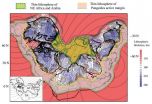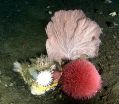Now, emulating this natural form of water-based locomotion, an international team of scientists from Seoul National University, Korea (SNU), Harvard's Wyss Institute for Biologically Inspired Engineering, and the Harvard John A. Paulson School of Engineering and Applied Sciences, has unveiled a novel robotic insect that can jump off of water's surface. In doing so, they have revealed new insights into the natural mechanics that allow water striders to jump from rigid ground or fluid water with the same amount of power and height. The work is reported in the July 31 issue of Science.
"Water's surface needs to be pressed at the right speed for an adequate amount of time, up to a certain depth, in order to achieve jumping," said the study's co-senior author Kyu Jin Cho, Associate Professor in the Department of Mechanical and Aerospace Engineering and Director of the Biorobotics Laboratory at Seoul National University. "The water strider is capable of doing all these things flawlessly."
The water strider, whose legs have slightly curved tips, employs a rotational leg movement to aid it its takeoff from the water's surface, discovered co-senior author Ho-Young Kim who is Professor in SNU's Department of Mechanical and Aerospace Engineering and Director of SNU's Micro Fluid Mechanics Lab. Kim, a former Wyss Institute Visiting Scholar, worked with the study's co-first author Eunjin Yang, a graduate researcher at SNU's Micro Fluid Mechanics lab, to collect water striders and take extensive videos of their movements to analyze the mechanics that enable the insects to skim on and jump off water's surface.
It took the team several trial and error attempts to fully understand the mechanics of the water strider, using robotic prototypes to test and shape their hypotheses.
"If you apply as much force as quickly as possible on water, the limbs will break through the surface and you won't get anywhere," said Robert Wood, Ph.D., who is a co-author on the study, a Wyss Institute Core Faculty member, the Charles River Professor of Engineering and Applied Sciences at the Harvard Paulson School, and founder of the Harvard Microrobotics Lab.
But by studying water striders in comparison to iterative prototypes of their robotic insect, the SNU and Harvard team discovered that the best way to jump off of water is to maintain leg contact on the water for as long as possible during the jump motion.
"Using its legs to push down on water, the natural water strider exerts the maximum amount of force just below the threshold that would break the water's surface," said the study's co-first author Je-Sung Koh, Ph.D., who was pursuing his doctoral degree at SNU during the majority of this research and is now a Postdoctoral Fellow at the Wyss Institute and the Harvard Paulson School.
Mimicking these mechanics, the robotic insect built by the team can exert up to 16 times its own body weight on the water's surface without breaking through, and can do so without complicated controls. Many natural organisms such as the water strider can perform extreme styles of locomotion - such as flying, floating, swimming, or jumping on water - with great ease despite a lack of complex cognitive skills.
"This is due to their natural morphology," said Cho. "It is a form of embodied or physical intelligence, and we can learn from this kind of physical intelligence to build robots that are similarly capable of performing extreme maneuvers without highly-complex controls or artificial intelligence."
The robotic insect was built using a "torque reversal catapult mechanism" inspired by the way a flea jumps, which allows this kind of extreme locomotion without intelligent control. It was first reported by Cho, Wood and Koh in 2013 in the International Conference on Intelligent Robots and Systems.
For the robotic insect to jump off water, the lightweight catapult mechanism uses a burst of momentum coupled with limited thrust to propel the robot off the water without breaking the water's surface. An automatic triggering mechanism, built from composite materials and actuators, was employed to activate the catapult.
To produce the body of the robotic insect, "pop-up" manufacturing was used to create folded composite structures that self-assemble much like the foldable components that "pop-up" in 3D books. Devised by engineers at the Harvard Paulson School and the Wyss Institute, this ingenious layering and folding process enables the rapid fabrication of microrobots and a broad range of electromechanical devices.
"The resulting robotic insects can achieve the same momentum and height that could be generated during a rapid jump on firm ground - but instead can do so on water - by spreading out the jumping thrust over a longer amount of time and in sustaining prolonged contact with the water's surface," said Wood.
"This international collaboration of biologists and roboticists has not only looked into nature to develop a novel, semi-aquatic bioinspired robot that performs an new extreme form of robotic locomotion, but has also provided us with new insights on the natural mechanics at play in water striders," said Wyss Institute Founding Director Donald Ingber, M.D., Ph.D.
INFORMATION:
Additional co-authors of the study include Gwang-Pil Jung, a Ph.D. candidate in SNU's Biorobotics Laboratory; Sun-Pill Jung, an M.S. candidate in SNU's Biorobotics Laboratory; Jae Hak Son, who earned his Ph.D. in SNU's Laboratory of Behavioral Ecology and Evolution; Sang-Im Lee, Ph.D., who is Research Associate Professor at SNU's Institute of Advanced Machines and Design and Adjunct Research Professor at the SNU's Laboratory of Behavioral Ecology and Evolution; and Piotr Jablonski, Ph.D., who is Professor in SNU's Laboratory of Behavioral Ecology and Evolution.
This work was supported by the National Research Foundation of Korea, Bio-Mimetic Robot Research Center funding from the Defense Acquisition Program Administration, and the Wyss Institute for Biologically Inspired Engineering at Harvard University.
IMAGES AND VIDEO AVAILABLE
The Seoul National University College of Engineering (SNU CE) aims to foster leaders in global industry and society. In CE, professors from all over the world are applying their passion for education and research. Graduates of the college are taking on important roles in society as the CEOs of conglomerates, founders of venture businesses, and prominent engineers, contributing to the country's industrial development. Globalization is the trend of a new era, and engineering in particular is a field of boundless competition and cooperation. The role of engineers is crucial to our 21st century knowledge and information society, and engineers contribute to the continuous development of Korea toward a central role on the world stage. CE, which provides enhanced curricula in a variety of major fields, has now become the environment in which future global leaders are cultivated.
The Wyss Institute for Biologically Inspired Engineering at Harvard University uses Nature's design principles to develop bioinspired materials and devices that will transform medicine and create a more sustainable world. Wyss researchers are developing innovative new engineering solutions for healthcare, energy, architecture, robotics, and manufacturing that are translated into commercial products and therapies through collaborations with clinical investigators, corporate alliances, and formation of new start-ups. The Wyss Institute creates transformative technological breakthroughs by engaging in high risk research, and crosses disciplinary and institutional barriers, working as an alliance that includes Harvard's Schools of Medicine, Engineering, Arts & Sciences and Design, and in partnership with Beth Israel Deaconess Medical Center, Brigham and Women's Hospital, Boston Children's Hospital, Dana-Farber Cancer Institute, Massachusetts General Hospital, the University of Massachusetts Medical School, Spaulding Rehabilitation Hospital, Boston University, Tufts University, and Charité - Universitätsmedizin Berlin, University of Zurich and Massachusetts Institute of Technology.
The Harvard John A. Paulson School of Engineering and Applied Sciences serves as the connector and integrator of Harvard's teaching and research efforts in engineering, applied sciences, and technology. Through collaboration with researchers from all parts of Harvard, other universities, and corporate and foundational partners, we bring discovery and innovation directly to bear on improving human life and society.


